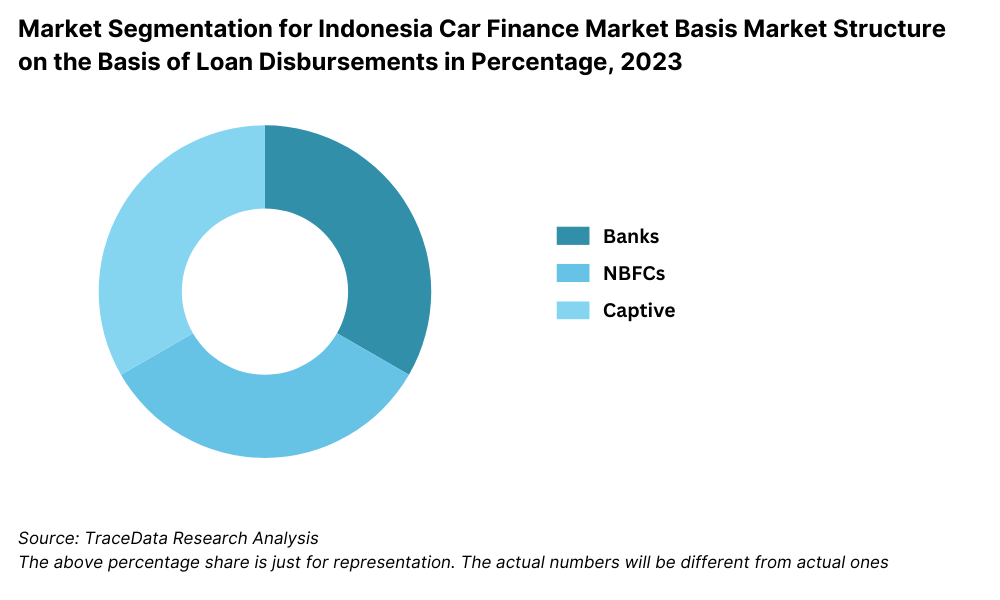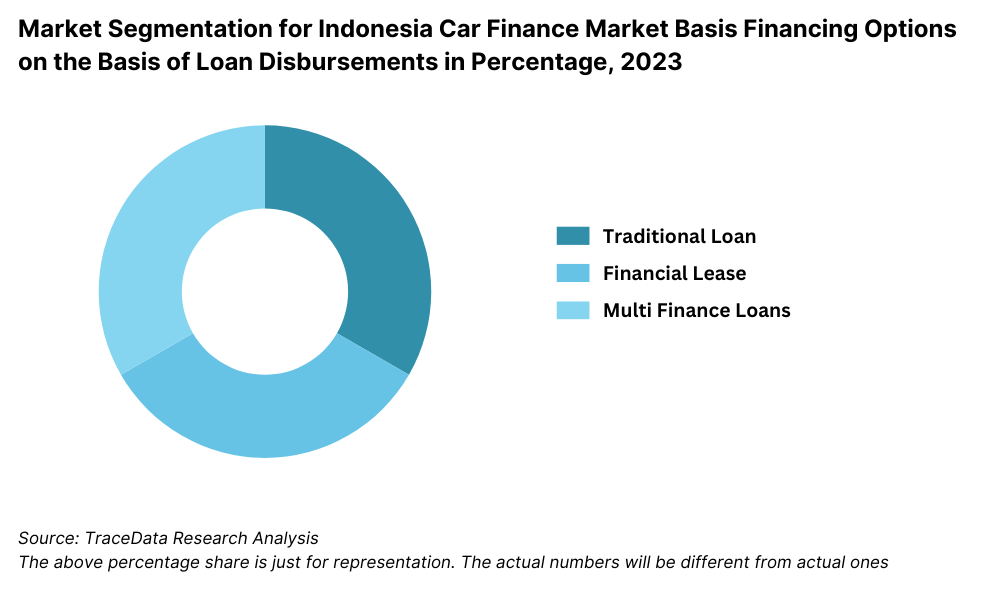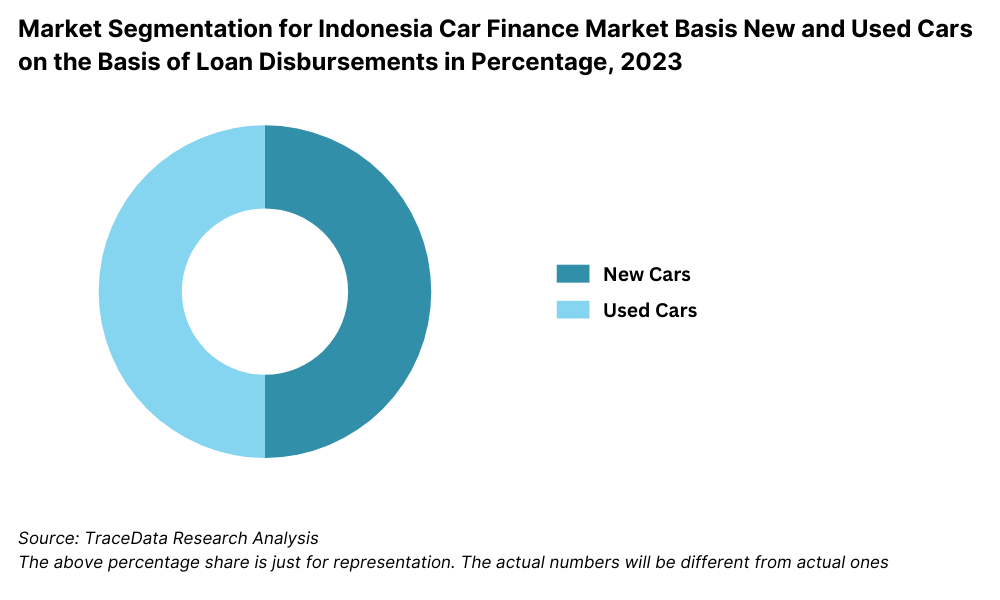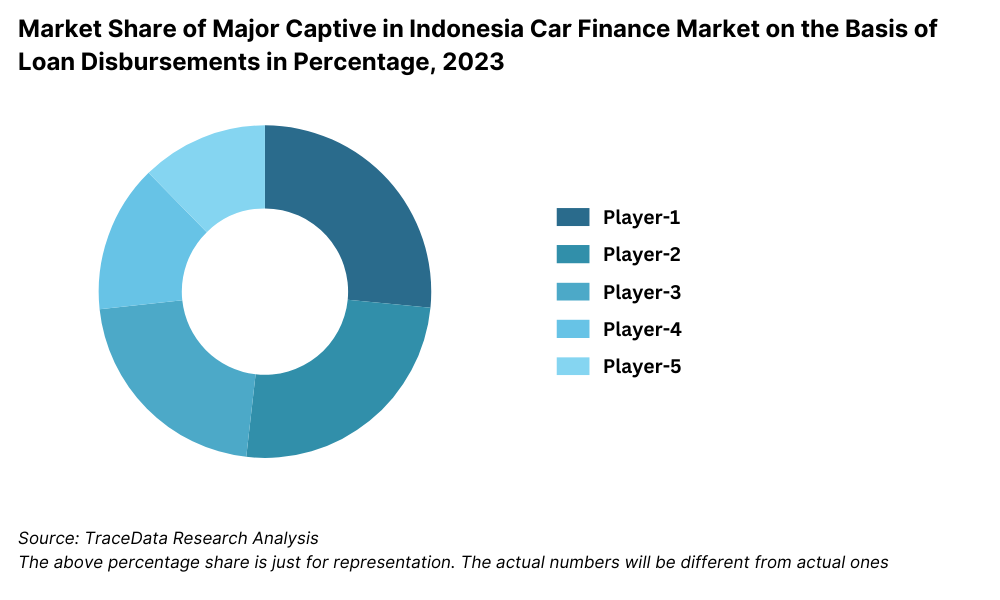Indonesia Car Finance Market Outlook to 2029
By Market Structure, By Financing Options, By Type of Vehicles, By Age of Consumers, and By Region
- Product Code: TDR0013
- Region: Asia
- Published on: September 2024
- Total Pages: 110
Introducing the World's FirstPay-Per-Section Market Reports
Why pay for the full report when you need just a part?
Start Building Your Report
Scroll down to see available sections
Report Summary
The report titled “Indonesia Car Finance Market Outlook to 2029 - By Market Structure, By Financing Options, By Type of Vehicles, By Age of Consumers, and By Region” provides a comprehensive analysis of the car finance market in Indonesia. The report covers an overview and genesis of the industry, overall market size in terms of revenue, market segmentation; trends and developments, regulatory landscape, customer level profiling, issues and challenges, and comparative landscape including competition scenario, cross-comparison, opportunities and bottlenecks, and company profiling of major players in the Car Finance Market. The report concludes with future market projections based on sales revenue, by market, product types, region, cause and effect relationship, and success case studies highlighting the major opportunities and cautions.
Indonesia Car Finance Market Overview and Size
The Indonesia car finance market reached a valuation of IDR 100 Trillion in 2023, driven by the growing demand for automotive financing solutions, an expanding middle class, and increasing vehicle ownership. The market is characterized by major players such as Bank Mandiri, BCA Finance, Astra Credit Companies (ACC), Mandala Multifinance, and Adira Dinamika Multi Finance. These companies are recognized for their extensive branch networks, diverse financial product offerings, and customer-centric services.
In 2023, BCA Finance introduced a new digital platform to streamline the loan application process, catering to the rising demand for online financial services in Indonesia. Key markets include Jakarta, Surabaya, and Bandung due to their high population density and robust automotive infrastructure.
Market Size for Indonesia Car Finance Industry Based on Loan Disbursements in IDR Trillion, 2018-2023

Source: TraceData Research Analysis
What Factors are Leading to the Growth of the Indonesia Car Finance Market:
Economic Expansion: Indonesia's growing economy and rising disposable incomes have led to an increase in vehicle ownership, with many consumers turning to car financing options. In 2023, car loans accounted for approximately 70% of total car purchases in Indonesia, reflecting a strong preference for financing solutions that make car ownership more affordable and accessible.
Expanding Middle Class: The expanding middle class in Indonesia, with a growing appetite for vehicle ownership, has significantly driven the demand for car financing. In recent years, the middle-income population in Indonesia has grown by 10%, creating a substantial market for car finance companies as more individuals seek financial support to purchase vehicles.
Digitalization: The rapid digitalization of financial services in Indonesia has transformed the car finance market. In 2023, approximately 35% of car loan applications were processed online, underscoring the shift towards digital channels. Online platforms now provide consumers with easy access to loan calculators, instant approvals, and transparent information, which has made car financing more convenient and attractive to a broader audience.
Which Industry Challenges Have Impacted the Growth of the Indonesia Car Finance Market:
High Interest Rates: The relatively high interest rates on car loans in Indonesia present a significant challenge. According to recent data, approximately 40% of consumers are reluctant to finance their car purchases due to interest rates ranging from 8% to 15% annually. This issue has led to affordability concerns, particularly among lower-income buyers, and has potentially deterred a sizable portion of prospective customers from opting for car financing.
Regulatory Hurdles: The complex regulatory environment in Indonesia, including stringent requirements for loan approvals and vehicle registrations, can impede market growth. In 2023, about 15% of loan applications were rejected due to non-compliance with regulatory standards. These hurdles can limit the availability of financing options, especially for smaller financial institutions, and can be particularly challenging for consumers in rural areas.
Credit Access: Limited access to credit, particularly for individuals without a robust credit history or sufficient collateral, is a major barrier in the Indonesia car finance market. Data suggests that around 30% of potential car buyers face challenges in securing financing due to these constraints. This limitation not only restricts access to car ownership for a significant portion of the population but also hampers overall market growth.
What are the Regulations and Initiatives Governing the Market:
Loan-to-Value Ratio Regulations: The Indonesian government has implemented regulations on the loan-to-value (LTV) ratio for car loans to ensure responsible lending practices. These regulations mandate that financial institutions can only finance up to 70% of the vehicle's value for new cars and 60% for used cars. In 2023, approximately 80% of car loans adhered to these LTV ratios, reflecting strong compliance across the industry.
Credit Bureau Reporting Requirements: To enhance transparency and reduce the risk of default, the government requires all financial institutions to report car loan data to credit bureaus. This initiative helps in maintaining a robust credit reporting system, ensuring that borrowers’ credit histories are accurately tracked. As of 2023, over 90% of car loan data was reported to credit bureaus, contributing to better risk management in the market.
Government Incentives for Electric Vehicles: To support the growth of electric vehicle (EV) adoption, the Indonesian government has introduced incentives for EV financing, including lower interest rates and tax exemptions. These incentives are aimed at making EVs more affordable and accessible through financing. In 2023, EVs accounted for about 5% of new car loans, a figure expected to rise as these incentives gain traction.
Indonesia Car Finance Market Segmentation
By Market Structure: Bank-owned financial institutions dominate the market due to their extensive branch networks, established customer relationships, and competitive interest rates. These institutions often offer personalized loan products, attractive interest rates, and better customer service. Multi-finance companies hold a significant share because they provide more flexible loan options and faster approval processes, catering to a broader segment of the population, including those with limited credit histories.

By Financing Options: Traditional bank loans lead the market due to their reliability, lower interest rates, and extensive reach across urban and rural areas. Leasing options are increasingly popular among corporate clients and individuals looking for flexible ownership solutions, while multi-finance loans appeal to those seeking quicker approval and less stringent credit requirements.

By Type of Vehicles: Financing for new vehicles dominates the market, driven by consumer preference for the latest models and features. However, financing for used vehicles is also significant, particularly among budget-conscious buyers who seek affordable options. The financing of electric vehicles (EVs) is a growing segment, supported by government incentives and increasing consumer interest in sustainable transportation.

Competitive Landscape in Indonesia Car Finance Market
The Indonesia car finance market is moderately fragmented, with several key players leading the space. However, the growth of fintech companies and the increasing adoption of digital platforms have diversified the market, offering consumers a broader range of financing options and services.
| Name | Type | Founding Year | Headquarters |
| Bank Mandiri | Bank | 1998 | Jakarta, Indonesia |
| Bank Central Asia (BCA) | Bank | 1957 | Jakarta, Indonesia |
| Bank Rakyat Indonesia (BRI) | Bank | 1895 | Jakarta, Indonesia |
| Bank Negara Indonesia (BNI) | Bank | 1946 | Jakarta, Indonesia |
| Adira Finance | NBFC | 1990 | Jakarta, Indonesia |
| BCA Finance | NBFC | 1981 | Jakarta, Indonesia |
| Mandiri Tunas Finance | NBFC | 1989 | Jakarta, Indonesia |
| OTO Multiartha | NBFC | 1994 | Jakarta, Indonesia |
| Toyota Astra Finance | Captive | 2006 | Jakarta, Indonesia |
| Astra Credit Companies (ACC) | Captive | 1982 | Jakarta, Indonesia |
| Suzuki Finance Indonesia | Captive | 2005 | Jakarta, Indonesia |
| Honda Prospect Motor Finance | Captive | 2003 | Jakarta, Indonesia |
Some of the recent competitor trends and key information about competitors include:
Bank Mandiri: As one of Indonesia's largest state-owned banks, Bank Mandiri has a strong presence in the car finance market, with a focus on offering competitive interest rates and extensive loan products. In 2023, the bank processed over IDR 20 trillion in car loans, marking a 10% increase from the previous year, driven by its robust branch network and digital lending platform.
BCA Finance: Known for its strong customer service and attractive financing packages, BCA Finance recorded a 15% growth in car loan disbursements in 2023. The company's focus on digital innovation, including a user-friendly mobile app for loan applications, has significantly boosted its market position.
Astra Credit Companies (ACC): A major player in the market, ACC offers a wide range of financing options, including loans for new and used vehicles. In 2023, ACC reported a 12% increase in loan disbursements, bolstered by its extensive dealer network and partnerships with major automotive brands.
Mandala Multifinance: Specializing in providing financing for used vehicles, Mandala Multifinance saw a 20% growth in loan approvals in 2023, particularly in rural and semi-urban areas. The company’s flexible loan terms and focus on underserved markets have been key to its success.
Adira Dinamika Multi Finance: A leader in the multi-finance sector, Adira Dinamika has been expanding its digital services, resulting in a 17% increase in car loans in 2023. The company’s strategic partnerships with e-commerce platforms and automotive dealerships have enhanced its reach and customer base.



What Lies Ahead for Indonesia Car Finance Market?
The Indonesia car finance market is projected to grow steadily by 2029, exhibiting a respectable CAGR during the forecast period. This growth is expected to be driven by economic expansion, rising vehicle ownership, and increasing consumer confidence in financial institutions.
Shift Towards Electric Vehicles (EVs): As the Indonesian government continues to promote the adoption of electric vehicles through various incentives, there is expected to be a gradual increase in both the availability and demand for EV financing. This trend is supported by growing environmental awareness and favorable government policies, making EVs more accessible to the broader population.
Integration of Digital Technologies: The integration of advanced digital technologies, such as AI and big data analytics, in loan approval and risk assessment processes is anticipated to provide consumers with more accurate and faster services. These technological advancements will enhance transparency, improve customer experiences, and streamline the loan application process, making car financing more efficient and appealing.
Expansion of Financial Inclusion: The market is likely to see a continued focus on financial inclusion, with initiatives aimed at providing access to credit for underserved populations, particularly in rural areas. Efforts to expand microfinance and alternative credit scoring models are expected to bring more consumers into the formal car finance market.
Growth of Sustainable Financing: There is a rising trend towards sustainable financing within the car finance market. This includes offering favorable terms for loans on eco-friendly vehicles and supporting green initiatives through financial products. These practices are becoming increasingly important to both consumers and financial institutions and are expected to play a significant role in the future growth of the market.
Future Outlook and Projections for Indonesia Car Finance Market on the Basis of Loan Disbursements in IDR Trillion, 2024-2029

Source: TraceData Research Analysis

Indonesia Car Finance Market Segmentation
By Market Structure:
Banks
NBFCs
Captives
By Financing Options:
Traditional Bank Loans
Multi-Finance Loans
Leasing
By Type of Vehicles:
New Vehicles
Used Vehicles
Electric Vehicles
By Age of Consumer:
18-34
35-54
55+
By Region:
Java
Sumatra
Kalimantan
Sulawesi
Papua
Players Mentioned in the Report (Banks):
Bank Mandiri (Founded: 1998, Headquarters: Jakarta)
Bank Central Asia (BCA) (Founded: 1957, Headquarters: Jakarta)
Bank Rakyat Indonesia (BRI) (Founded: 1895, Headquarters: Jakarta)
Bank Negara Indonesia (BNI) (Founded: 1946, Headquarters: Jakarta)
Players Mentioned in the Report (NBFCs):
Adira Finance (Founded: 1990, Headquarters: Jakarta)
BCA Finance (Founded: 1981, Headquarters: Jakarta)
Mandiri Tunas Finance (Founded: 1989, Headquarters: Jakarta)
OTO Multiartha (Founded: 1994, Headquarters: Jakarta)
Players Mentioned in the Report (Captive):
Toyota Astra Finance (Founded: 2006, Headquarters: Jakarta)
Astra Credit Companies (ACC) (Founded: 1982, Headquarters: Jakarta)
Suzuki Finance Indonesia (Founded: 2005, Headquarters: Jakarta)
Honda Prospect Motor Finance (Founded: 2003, Headquarters: Jakarta)
Key Target Audience:
Car Finance Companies
Automotive Dealerships
Regulatory Bodies (e.g., Financial Services Authority)
Research and Development Institutions
Time Period:
Historical Period: 2018-2023
Base Year: 2024
Forecast Period: 2024-2029
Report Coverage
Choose individual sections to purchase. Mix and match as you like.
- -
- -
- $100
4.1. Value Chain Process-Role of Entities, Stakeholders, and challenges they face.
4.2. Relationship and Engagement Model between Banks-Dealers, NBFCs-Dealers and Captive-Dealers-Commission Sharing Model, Flat Fee Model and Revenue streams
4.3. Supply Decision-Making Process
$2505.1. New Car and Used Car Sales in Indonesia by type of vehicle, 2018-2024
$150- $100
- $200
8.1. Credit Disbursed, 2018-2024
8.2. Outstanding Loan, 2018-2024
$3009.1. By Market Structure (Bank-Owned, Multi-Finance, and Captive Companies), 2023-2024P
9.2. By Financing Options (Traditional Loans, Leasing, Multi-Finance Loans), 2023-2024P
9.3. By Region, 2023-2024P
9.4. By Type of Vehicle (New, Used, Electric), 2023-2024P
9.5. By Average Loan Tenure (0-2 years, 3-5 years, 6-8 years, Above 8 years), 2023-2024P
$40010.1. Customer Landscape and Cohort Analysis
10.2. Customer Journey and Decision-Making
10.3. Need, Desire, and Pain Point Analysis
10.4. Gap Analysis Framework
$50011.1. Trends and Developments for Indonesia Car Finance Market
11.2. Growth Drivers for Indonesia Car Finance Market
11.3. SWOT Analysis for Indonesia Car Finance Market
11.4. Issues and Challenges for Indonesia Car Finance Market
11.5. Government Regulations for Indonesia Car Finance Market
$20012.1. Market Size and Future Potential for Online Car Financing Aggregators, 2018-2029
12.2. Business Model and Revenue Streams
12.3. Cross Comparison of Leading Digital Car Finance Companies Based on Company Overview, Revenue Streams, Loan Disbursements/Number of Leads Generated, Operating Cities, Number of Branches, and Other Variables
$50013.1. Finance Penetration Rate and Average Down Payment for New and Used Cars, 2018-2029
13.2. How Finance Penetration Rates are Changing Over the Years with Reasons
13.3. Type of Car Segment for which Finance Penetration is Higher
$250- $250
- $250
- $150
17.1. Market Share of Key Banks in Indonesia Car Finance Market, 2023
17.1. Market Share of Key NBFCs in Indonesia Car Finance Market, 2023
17.1. Market Share of Key Captive in Indonesia Car Finance Market, 2023
17.1. Benchmark of Key Competitors in Indonesia Car Finance Market, including Variables such as Company Overview, USP, Business Strategies, Strengths, Weaknesses, Business Model, Number of Branches, Product Features, Interest Rate, NPA, Loan Disbursed, Outstanding Loans, Tie-Ups and others
17.2. Strengths and Weaknesses
17.3. Operating Model Analysis Framework
17.4. Gartner Magic Quadrant
17.5. Bowmans Strategic Clock for Competitive Advantage
$75018.1. Credit Disbursed, 2025-2029
18.2. Outstanding Loan, 2025-2029
$30019.1. By Market Structure (Bank-Owned, Multi-Finance, and Captive Companies), 2025-2029
19.2. By Financing Options (Traditional Loans, Leasing, Multi-Finance Loans), 2025-2029
19.3. By Region, 2025-2029
19.4. By Type of Vehicle (New, Used, Electric), 2025-2029
19.5. By Average Loan Tenure (0-2 years, 3-5 years, 6-8 years, Above 8 years), 2025-2029
20.1. Recommendation
21.2. Opportunity Analysis
$400
Research Methodology
Step 1: Ecosystem Creation
Map the ecosystem and identify all the demand-side and supply-side entities for the Indonesia Car Finance Market. Based on this ecosystem, we will shortlist leading 5-6 financial institutions in the country based on their financial information, loan disbursement capacity, and market share.
Sourcing is made through industry articles, multiple secondary sources, and proprietary databases to perform desk research around the market to collate industry-level information.
Step 2: Desk Research
Subsequently, we engage in an exhaustive desk research process by referencing diverse secondary and proprietary databases. This approach enables us to conduct a thorough analysis of the market, aggregating industry-level insights. We delve into aspects such as loan disbursements, number of market players, interest rate trends, demand, and other variables. We supplement this with detailed examinations of company-level data, relying on sources like press releases, annual reports, financial statements, and similar documents. This process aims to construct a foundational understanding of both the market and the entities operating within it.
Step 3: Primary Research
We initiate a series of in-depth interviews with C-level executives and other stakeholders representing various Indonesia Car Finance Market companies and end-users. This interview process serves a multi-faceted purpose: to validate market hypotheses, authenticate statistical data, and extract valuable operational and financial insights from these industry representatives. A bottom-to-top approach is undertaken to evaluate loan disbursements for each player, thereby aggregating to the overall market.
As part of our validation strategy, our team conducts disguised interviews wherein we approach each company under the guise of potential customers. This approach enables us to validate the operational and financial information shared by company executives, corroborating this data against what is available in secondary databases. These interactions also provide us with a comprehensive understanding of revenue streams, value chains, processes, pricing, and other factors.
Step 4: Sanity Check
- Bottom-to-top and top-to-bottom analyses along with market size modeling exercises are undertaken as part of the sanity check process to ensure data accuracy and reliability.
FAQs
01 What is the potential for the Indonesia Car Finance Market?
The Indonesia car finance market is poised for substantial growth, with a projected valuation of IDR 100 Trillion by 2029. This growth is driven by factors such as rising vehicle ownership, economic expansion, and increasing consumer confidence in financial institutions. The market's potential is further enhanced by the adoption of digital financial services, which make loan applications more accessible and convenient for consumers across the country.
02 Who are the Key Players in the Indonesia Car Finance Market?
The Indonesia Car Finance Market features several key players, including Bank Mandiri, BCA Finance, and Astra Credit Companies (ACC). These institutions dominate the market due to their extensive branch networks, competitive interest rates, and diverse loan offerings. Other notable players include Mandala Multifinance and Adira Dinamika Multi Finance.
03 What are the Growth Drivers for the Indonesia Car Finance Market?
The primary growth drivers include economic expansion, which has led to increased disposable incomes and higher vehicle ownership rates. The expanding middle class in Indonesia, combined with the rise of digital financial platforms, also contributes to the growing demand for car financing. Additionally, government incentives for electric vehicles (EVs) are expected to boost the market further by promoting the adoption of EVs through favorable financing options.
04 What are the Challenges in the Indonesia Car Finance Market?
The Indonesia Car Finance Market faces several challenges, including high interest rates that can deter potential borrowers, especially those in lower-income brackets. Regulatory challenges, such as stringent loan approval processes and vehicle registration requirements, can also limit market growth. Additionally, limited access to credit in rural areas poses a significant barrier, restricting the ability of a large segment of the population to secure financing for vehicle purchases.